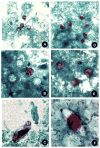Infections by Intestinal Coccidia and Giardia duodenalis
- PMID: 26004650
- PMCID: PMC4724871
- DOI: 10.1016/j.cll.2015.02.010
Infections by Intestinal Coccidia and Giardia duodenalis
Abstract
The coccidians Cryptosporidium spp, Cyclospora cayetanensis, and Cystoisospora belli and the flagellate Giardia duodenalis are pathogenic protozoa associated with gastrointestinal manifestations. Diagnosis relies heavily on microscopy, and although ova-and-parasite examinations can detect Giardia and Cystoisospora, Cryptosporidium and Cyclospora often require specific diagnostic requests. Approved non-microscopy methods are available for Giardia and Cryptosporidium, although negative results are frequently followed by microscopic assays. Polymerase chain reaction-based methods are not frequently used for diagnosis of Giardia and Cryptosporidium and have been used primarily for epidemiologic or outbreak investigations of Giardia and Cryptosporidium.
Keywords: Cryptosporidium; Cyclospora cayetanensis; Cystoisospora belli; Giardia duodenalis; Human enteric coccidian.
Published by Elsevier Inc.
Figures



Similar articles
-
Molecular characterization of the waterborne pathogens Cryptosporidium spp., Giardia duodenalis, Enterocytozoon bieneusi, Cyclospora cayetanensis and Eimeria spp. in wastewater and sewage in Guangzhou, China.Parasit Vectors. 2021 Jan 20;14(1):66. doi: 10.1186/s13071-020-04566-5. Parasit Vectors. 2021. PMID: 33472683 Free PMC article.
-
Development of Molecular Diagnosis Using Multiplex Real-Time PCR and T4 Phage Internal Control to Simultaneously Detect Cryptosporidium parvum, Giardia lamblia, and Cyclospora cayetanensis from Human Stool Samples.Korean J Parasitol. 2018 Oct;56(5):419-427. doi: 10.3347/kjp.2018.56.5.419. Epub 2018 Oct 31. Korean J Parasitol. 2018. PMID: 30419727 Free PMC article.
-
Molecular diversity and frequency of the diarrheagenic enteric protozoan Giardia duodenalis and Cryptosporidium spp. in a hospital setting in Northern Spain.PLoS One. 2017 Jun 15;12(6):e0178575. doi: 10.1371/journal.pone.0178575. eCollection 2017. PLoS One. 2017. PMID: 28617836 Free PMC article.
-
Detection of intestinal protozoa in the clinical laboratory.J Clin Microbiol. 2014 Mar;52(3):712-20. doi: 10.1128/JCM.02877-13. Epub 2013 Nov 6. J Clin Microbiol. 2014. PMID: 24197877 Free PMC article. Review.
-
Waterborne protozoan pathogens.Clin Microbiol Rev. 1997 Jan;10(1):67-85. doi: 10.1128/CMR.10.1.67. Clin Microbiol Rev. 1997. PMID: 8993859 Free PMC article. Review.
Cited by
-
Ocular Parasitosis Caused by Protozoan Infection during Travel: Focus on Prevention and Treatment.Int J Prev Med. 2018 Sep 17;9:79. doi: 10.4103/ijpvm.IJPVM_161_18. eCollection 2018. Int J Prev Med. 2018. PMID: 30283611 Free PMC article. Review.
-
Giardia duodenalis and Its Secreted PPIB Trigger Inflammasome Activation and Pyroptosis in Macrophages through TLR4-Induced ROS Signaling and A20-Mediated NLRP3 Deubiquitination.Cells. 2021 Dec 6;10(12):3425. doi: 10.3390/cells10123425. Cells. 2021. PMID: 34943932 Free PMC article.
-
Development of a new multiplex PCR to detect fecal coccidian parasite.Indian J Gastroenterol. 2023 Apr;42(2):241-248. doi: 10.1007/s12664-022-01315-7. Epub 2023 Mar 17. Indian J Gastroenterol. 2023. PMID: 36930399
-
Lymphocytic duodenitis or microscopic enteritis and gluten-related conditions: what needs to be explored?Ann Gastroenterol. 2017;30(4):380-392. doi: 10.20524/aog.2017.0165. Epub 2017 May 31. Ann Gastroenterol. 2017. PMID: 28655974 Free PMC article. Review.
-
Intestinal pseudo-obstruction caused by Giardia lamblia infection.BMJ Case Rep. 2022 Nov 2;15(11):e252319. doi: 10.1136/bcr-2022-252319. BMJ Case Rep. 2022. PMID: 36323453 Free PMC article.
References
-
- Bern C, Hernandez B, Lopez MB, et al. The contrasting epidemiology of Cyclospora and Cryptosporidium among outpatients in Guatemala. Am J Trop Med Hyg. 2000;63(5–6):231–5. - PubMed
-
- Ortega YR, Sterling CR, Gilman RH, et al. Cyclospora species–a new protozoan pathogen of humans. N Engl J Med. 1993;328(18):1308–12. - PubMed
-
- Duszynsky DW, Upton SJ, Couch L. The coccidia of the world. [Accessed December 8, 2014];Review of coccidia in humans and animals. 2014 Available at: http://biology.unm.edu/biology/coccidia/home.html.
Publication types
MeSH terms
Substances
Grants and funding
LinkOut - more resources
Full Text Sources
Other Literature Sources
Medical
Miscellaneous

